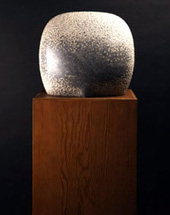Discussions about the sculptor Isamu Noguchi (1904-1988)
occasionally return to biographical issues that
emphasize the unresolved duality of his Japanese-ness
and American-ness. Noguchi himself often acknowledged
the point. He claimed that his double nationality
(from a Japanese father who abandoned him and his
American mother), in combination with an early childhood
spent living between two lands, left him with a
sense of not belonging anywhere. The discourse of
"in-between-ness" was readily transported
to Noguchi's later artistic interests. On modern
sculpture in 1949, he would say "we (sculptors)
are now more concerned with the relationship with
things than with things themselves. Our reality
is the space between."
Certainly, Noguchi imported Eastern references into
modern art by retrieving archaeological curiosities
like terracotta haniwa figurines or through
suggestive titles such as "Noh Musicians"
(1958-74). However, the "fusion of East and
West" that is occasionally imputed to the artist
seems untenable. An amusing example of just how
far Noguchi could be from traditional Japanese aesthetic
expectations came in the form of a private criticism
subjected to a teakettle Noguchi gifted to the tea
connoisseur Mirei Shigemori in 1958. Shigemori's
diary records: "This teakettle violates every
concept of what a conventional teakettle should
be. Maybe as art it's new, but Noguchi doesn't understand
what 'new' means for tea ceremony."
More plausibly, there is another kind of "in-between-ness"
at work in Noguchi's oeuvre, and that is the aesthetic
complicity between Japanese artistic ideals and
tenets of modernism, founded in general terms like
truth to materials and the appreciation of simplicity.
Noguchi better fitted the modernist mold than the
role of the bearer of Japanese traditions in 20th
century art.
Stylistically, Noguchi's gravitation to modernism
began with a Guggenheim fellowship in 1928 that
meant he could assist the sculptor Constantin Brancusi
at his studio for six months. Returning to New York
in 1928-29, Noguchi's abstractions were exhibited
but failed to sell, so he turned to doing portrait
busts of the well-to-do, such as that of "Joella
Levy" (1929) in order to forge a living. His
1946 selection for the Museum of Modern Art show
"Fourteen Americans" was his first public
success.
A work from that show and in this, "Gregory"
(1945-69) (originally titled "Effigy"
and made of stone), is a collection of biomorphic
shapes oddly conjoined into an upright, organically
smooth formation. Such a work was assured in its
converse with the earlier modernist master, the
due for which was formally established in the title
of another, "Maiastra: Homage to Brancusi"
(1971). Speaking of his debt, the sculptor explained,
"Brancusi brought back the discovery of the
material itself. What I am doing is a similar sort
of thing." Noguchi's modernist sympathies developed
by imposing the kind of limitations his contemporaries
were pursuing, such as his early aversion to welding,
which he thought "artificial," as a form
of honesty to materials, the reduction to simple
forms, minimal expression and the like, as key modernist
values.
Noguchi too was the very thing of the modernist critic
Clement Greenberg's discernment that the mediums
were "exploding," in contrast to an earlier
hermeticism, perceived in particular in the Abstract
Expressionist movement. "Painting turns into
sculpture, sculpture into architecture, engineering,
theater, environment, participation," claimed
Greenberg. "The boundaries between art and
everything that is not art are being obliterated."
Noguchi's earthworks, envisioned 30 or so years
before such terminology as "environmental sculpture"
had become part of the art vernacular, emphasized
sculpture as a "place." Noguchi's playground
designs for children confirmed as much.
 |
|
Childhood,
1971
Aji granite, 32.5 x 37.8 x 33 cm
The Museum of Modern Art, Shiga
|
His commercial designs, such as the "Akari"
lamp in particular, and coffee tables and furniture
in general, continue to feature in contemporary
homes, so highlighting Noguchi's continuing appeal
to popular tastes. The more strictly reductive aims
and modernist austerity of his sculptural practice,
however, such as "Life of a Cube" (1968),
have ensured more modest followings. In that light,
it appears Noguchi connected to a greater part of
the world through his furniture designs, rather
than in sculpture.
|
|